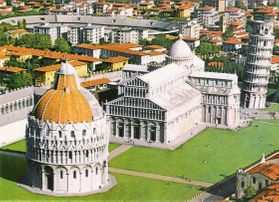Action TU1208
Civil Engineering Applications of Ground Penetrating Radar
COST Success Story
Training School on Civil Engineering Applications of GPR
Pisa, Italy, September 22-25, 2014
The Action TU1208 is organising a COST Training School on Civil Engineering Applications of Ground Penetrating Radar.
The school will be held in the School of Engineering, University of Pisa, Largo Lucio Lazzarino 2, Pisa, Italy, on September 22-25, 2014.
Topics of the School will be: GPR basics and history, how to conduct a survey, the main applications of GPR in civil engineering (with a particular focus to the surveying of transport
infrastructures and soil-moisture characterisation), design of GPR systems, radar interferometry, electromagnetic techniques for the modelling of GPR scenarios, and finally imaging, inversion and migration techniques for the interpretation of GPR data. The School will include 21 hours of lectures, 8 hours of lessons in the training laboratory of an important GPR manufacturer, and a final test.
The Coordinator of the Training School is Prof. Giuseppe Schettini (Roma Tre University, Italy, TU1208 WG Member). The Organising Committee is composed of Prof. Massimo Losa (University of Pisa, Italy), Dr. Lara Pajewski (Roma Tre University, Italy, TU1208 MC Chair), and Prof. Giuseppe Schettini.
The Trainers are: Prof. Amir Morteza Alani (The University of Greenwich, United Kingdom, TU1208 MC Member), Prof. Andrea Benedetto (Roma Tre University, Italy, TU1208 Editorial Coordinator), Dr. Xavier Derobert (IFSTTAR, France, TU1208 MC Member and WG2 Co-Chair), Prof. Antonis Giannopoulos (The University of Edinburgh, United Kingdom, TU1208 MC Member and WG3 Chair), Prof. Sébastien Lambot (Université Catholique de Louvain, Belgium, TU1208 MC Member), Prof. Massimo Losa, Dr. Guido Manacorda (IDS Ingegneria dei Sistemi SpA, Italy, TU1208 MC Member and WG1 Chair), Prof. Andrea Massa (ELEDIA Research Center, Italy, TU1208 MC Member), Dr. Lara Pajewski, Dr. Cristina Ponti (Roma Tre University, Italy, TU1208 WG Member), Prof. Giuseppe Schettini, and Prof. Jan van der Kruk (Forschungszentrum Jülich, Germany, TU1208 WG3 Co-Chair).
The COST Action TU1208 is glad to offer this course without requesting a registration fee and it is still possible to register!
Who can participate? Participants from all over the world are welcome! To register, please send an email to school@gpradar.eu.
Class Scheduling (still subject to change)
Monday, 22 September 2014
Introduction to GPR. Basics on GPR modelling and inversion.
Time | Teacher | Activity |
10:00 - 11:00 | G. Schettini | Welcome with authorities. Introduction to GPR and to the school. |
11:00 - 11:15 | Tea and coffee break | |
11:15 - 13:15 | A. Massa | Principles of inverse scattering techniques applied to GPR. |
13:15 - 14:15 | Lunch break | |
14:15 - 16:15 | L. Pajewski | Understanding GPR via electromagnetic modelling. |
16:15 - 16:30 | Tea and coffee break | |
16:30 - 18:30 | C. Ponti | The Cylindrical Wave Approach. |
Tuesday, 23 September 2014
GPR applications in civil engineering (1/3). Design of GPR systems.
Time | Teacher | Activity |
09:00 - 11:00 | X. Derobert | Applications of the GPR technique in civil engineering. |
11:00 - 11:15 | Tea and coffee break | |
11:15 - 13:15 | S. Lambot | Non-invasive soil moisture characterisation using GPR: from ray-based to full-wave methods. |
13:15 - 14:15 | Lunch break | |
14:15 - 16:15 | G. Manacorda | Visit to a training Laboratory: principles of GPR design. |
16:15 - 16:30 | Tea and coffee break | |
16:30 - 18:30 | G. Manacorda | Visit to a training Laboratory: evolution of the radar technique. |
20:00 | Common dinner |
Wednesday, 24 September 2014
GPR applications in civil engineering (2/3). Electromagnetic modelling with FDTD (1/2).
How to plan and conduct a survey. Radar interferometry.
Time | Teacher | Activity |
09:00 - 11:00 | A. M. Alani | Use of GPR and other non-destructive techniques for the monitoring of bridge and tunnel structures. |
11:00 - 11:15 | Tea and coffee break | |
11:15 - 13:15 | A. Giannopoulos | FDTD electromagnetic modelling. |
13:15 - 14:15 | Lunch break | |
14:15 - 16:15 | G. Manacorda | Visit to a training Laboratory: how to plan and conduct a survey. |
16:15 - 16:30 | Tea and coffee break | |
16:30 - 18:30 | G. Manacorda | Visit to a training Laboratory: use of the radar interferometry. |
Thursday, 25 September 2014
GPR applications in civil engineering (3/3). Electromagnetic modelling with FDTD (2/2).
Imaging, migration and full-waveform inversion techniques.
Time | Teacher | Activity |
09:00 - 11:00 | M. Losa and A. Benedetto | Use of the GPR technique for road monitoring. |
11:00 - 11:15 | Tea and coffee break | |
11:15 - 13:15 | A. Giannopoulos | An example on how to use the FDTD technique to simulate a complex scenario. |
13:15 - 14:15 | Lunch break | |
14:15 - 16:15 | J. van der Kruk | Principles of imaging/migration and full-waveform inversion of GPR data. |
16:15 - 16:30 | Tea and coffee break | |
16:30 - 18:30 | All | Final test |
Training School Grants for PhD Students & ESR
The COST Action TU1208 offered 25 grants of 500,00 EUR to students and young researchers willing to attend the Training School on Civil Engineering Applications of GPR. The COST Training School grants represent a contribution to cover travel, meal and accommodation expenses. The deadline for submitting grant applications was August 24, 2014, 18:00 CEST time.
Four COST Training School grants have been offered to the GPR2014 Awarded Early-Stage Researchers:
- De Coster Albéric, Belgium
- Feld Ralph, Netherlands
- Giannakis Iraklis, United Kingdom
- Santos Assuncao Sonia, Spain
The CVs of the grant Applicants have been examined by the Coordinator of the Training School and the Trainees whose application has been granted are:
- Abad Rodriguez Isabel, Spain
- Battaglia Enzo, Italy
- Bianchini Ciampoli Luca, Italy
- Boukhemacha M. Amine, Romania
- Cruceru Ramona, Romania
- Dogan A. Unal, Turkey
- Gheorghe Sabina Elena, Romania
- Ghituica Ana Maria, Romania
- Harley Ruth, United Kingdom
- Marecos Vania, Portugal
- Matera Loredana, Italy
- Ogretmen Zeynep, Turkey
- Oskars Purmalis, Latvia
- Ozgur Ekincioglu, Turkey
- Podd Frank, United Kingdom
- Prontera Santo, Italy
- Serpescu Irina, Romania
- Sileo Maria, Italy
- Xiaoting Xiao, France
- Zhen Chen, United Kingdom
- Zhihai Luo, United Kingdom
After the School, the granted Trainees coordinate between themselves, in order to write a joint report, answering to a series of questions and providing information about the GPR activities in their Countries.
How to reach Pisa
By Air
Tuscany has two international airports, the Galileo Galilei International Airport in Pisa and Amerigo Vespucci Airport, also known as Peretola, in Florence. Both airports handle flights to major European cities. Pisa handles the bulk of European scheduled flights so it might be easier to find flights into Pisa rather than into Florence. Direct flights from other continents are generally more expensive than stopover routes somewhere else in Europe. More affordable fares can be found if one flies non-stop to a major European city such as London, Paris, Brussels or Berlin, and then takes a Ryan Air (low-fare European airline) flight direct to Pisa. You'll have to change airports in London, Paris and Berlin, though, as Ryan Air generally uses secondary airports.
The Pisa airport terminal is connected to Pisa Central Station by direct train service (5'), with many trains to the Pisa central station and with eight trains a day from the Pisa airport to the main Florence train station (50'). The railway terminal is located just outside the departures hall. You can also reach the center of Pisa with bus or taxi service (10'). The Florence airport also is located on the north western edge of Florence; taxis and a bus shuttle connect the airport to Florence's historical center (15'). From Florence airport you can reach the Pisa airport terminal by a bus shuttle (60').
By Train
The Italian railway system is well connected with the rest of the European rail system, so it is easy to reach Tuscany from locations across Europe and Italy. The main route that passes through Tuscany is via Florence, on the Bologna-Rome line. Another line from Rome hugs the Tyrrhenian sea coast and passes through Pisa. Florence and Pisa are connected by a speedy regional train (50'). Florence's main train station is Santa Maria Novella (SMN). High-Speed trains arrive to Florence from Rome (90') and Milan (105') and to Pisa from Rome (150').
For information concerning COST Action TU1208 and TU1208 GPR Association, please take contact with the Chair of the Action and President of the Association, Prof. Lara Pajewski. From 4 April 2013 to 3 October 2017, this website was supported by COST, European Cooperation in Science and Technology - COST is supported by the EU RTD Framework Programme Horizon2020. TU1208 Members are deeply grateful to COST for funding and supporting COST Action TU1208. As of 4 October 2017, this website is supported by TU1208 GPR Association, a non-profit association stemming from COST Action TU1208.



